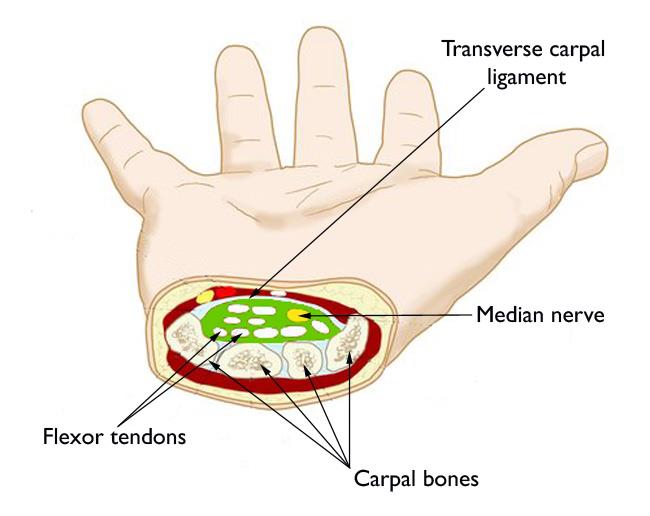- Conditions
- Procedures
- Patient care
- Why choose us
- Our Doctors
- Contact
Carpal Tunnel Syndrome

Carpal tunnel syndrome overview
Carpal tunnel syndrome describes a painful condition that affects the wrist joints. Also known as medial nerve compression, carpal tunnel syndrome is an overuse injury that is very common in people who work in offices or perform repetitive wrist motions. Carpal tunnel syndrome is a progressive condition that gets worse over time, so it is important to be proactive as you attempt to treat this condition.
Carpal tunnel syndrome may be most commonly associated with people who work office jobs, but it can affect anyone who engages in repetitive wrist motions. It can also develop in people who have certain conditions. This is why any persistent wrist pain should be taken seriously and treated by a medical professional.
While carpal tunnel syndrome can be difficult to live with and can diminish productivity and hobbies, there are effective treatments to help manage symptoms. At USA Spine Care, we believe that patient education is essential to treatment. By learning more about this condition and its causes, you can be more engaged with the entire care process.
Carpal tunnel syndrome — common causes and risk factors
The wrist joint is a very thin passageway through which a high volume of nerves and blood vessels must pass through. When carpal tunnel syndrome begins to develop, this narrow passage becomes compressed, which can negatively affect the soft tissue, vessels and nerves within, including the medial nerve. This compression is usually the result of inflammation of the transverse carpal ligament, which constricts the nerves against the carpal wrist bones and causes neuropathic symptoms.
There are a number of specific risk factors that can lead to a higher likelihood of carpal tunnel syndrome developing in patients, these include:
- A history of carpal tunnel syndrome in your family
- Repetitive hand use, such as typing or twisting
- Wrist posture issues that put excessive pressure on the nerve
- The presence of another condition such as diabetes, arthritis or a thyroid condition
Practicing a healthy lifestyle that includes taking regular breaks from repetitive wrist motions, using good hand and wrist posture and eating a healthy anti-inflammatory diet are all ways to decrease the risk of developing carpal tunnel syndrome.
Symptoms of carpal tunnel syndrome
The most common symptoms of carpal tunnel syndrome include:
- Wrist pain and soreness
- Neuropathic symptoms from nerve compression including tingling, numbness and a burning sensation
- Radiating symptoms that travel up the arm
- Weakness in the arm and hand
Since symptoms may be similar to another wrist condition or injury, it is important to see a qualified physician for diagnosis and treatment.
Diagnosing carpal tunnel syndrome
Long-term nerve compression can lead to permanent nerve damage, making it more difficult to find relief from pain and other symptoms. This is why if a doctor can diagnose carpal tunnel syndrome early, there is a better chance of finding a successful treatment plan.
When working with a doctor to diagnose wrist pain and neuropathic symptoms that are potentially related to carpal tunnel syndrome, the process will include a review of medical history followed by a discussion of symptoms. Physicians should perform a hands-on evaluation to test range of motion and determine if there are specific movements that cause pain.
In some cases, an MRI or X-ray may be ordered to help confirm diagnosis by showing the presence of inflamed tissue and rule out other injuries.
Carpal tunnel syndrome treatment options
Upon diagnosis of carpal tunnel syndrome, treatment usually begins with conservative options.The recommendations for carpal tunnel syndrome often include:
- Wearing a brace or splint to limit movement and relieve pressure on the wrist
- Over-the-counter medications to reduce pain and inflammation
- Physical therapy to strengthen the wrist and improve flexibility
- Wrist posture training to lessen strain on the wrist during daily activities
- Steroid injections to relieve inflammation
Conservative options are often very effective in helping to manage carpal tunnel syndrome, but surgery can become a consideration if the condition does not respond to nonsurgical therapy.
Surgical options for carpal tunnel syndrome
The primary type of surgery used to treat carpal tunnel syndrome is known as a carpal tunnel release, or carpal tunnel decompression. Often this type of carpal tunnel syndrome surgery can be performed on an outpatient basis with a small incision and the use of direct visualization technology. The goal of the procedure is to carefully enter the wrist and remove a small amount of tissue from the transverse carpal ligament to make space in the wrist and relieve medial nerve compression.
Find out about carpal tunnel syndrome treatment options
At USA Spine Care, we have a wide range of treatment options for carpal tunnel syndrome and a caring staff with years of experience in helping people find relief. Our goal is to help people find a personalized treatment journey that helps them rediscover the quality of life they deserve. To learn more, contact us today.
Call toll free 1- 866-249-1627
